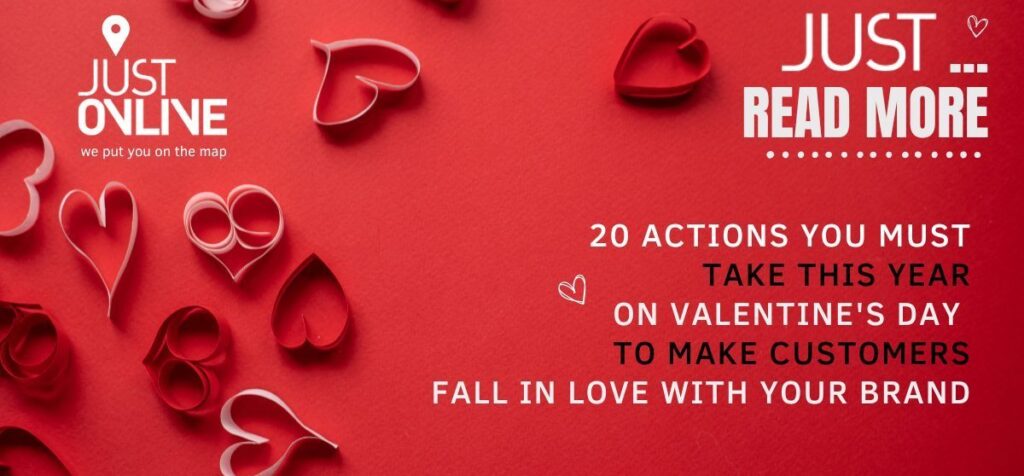
In about 2 weeks we celebrate one of the most controversial and commercialized holidays: Valentine’s Day.
That’s why we have prepared a list of 20 actions that you must take in order to bring customers into the arms of your … e-shop and make them fall in love with your brand
Eshop
Homepage: change your main banner with one or more themed banners or make a special visual high on your homepage for Valentine’s Day. Describe the actions you are taking for this day (discounts, special gifts, contests)

Special landing page: create a special page where all your Valentine’s Day social media posts and ads will end up.
This page can include the categories of products you recommend for the day, gift ideas based on the gender, age and money available, a contest and product delivery information.
Logo: make a Valentine-themed variation of your logo
Trade policy: limited number of pieces, discounts, 2+1 gifts and (of course) free shipping are some of the trade policies you can use to make your visitors buy from you without looking for alternatives in other eshops
Contest: create a popup (or special banner) that will lead to a Valentine contest (more about contests at the end of the article).
Product delivery: make clear (with a banner or even a countdown mechanism) the last day and time you need to receive the order in order to deliver it on time.
Even better, make a special deal with the courier company you work with for extra fast orders and inform your eshop visitors about fee gradations.
Email & Viber
If you’ve run Valentine’s Day contests in the past, the list you’ve created is the hottest to use again to bring back Valentine’s Day attendees to your eshop in previous years.
To get even more information from your already registered users, ask them if they are looking for a gift, how much money they want to allocate and for which gender so that you can send them corresponding ready-made proposals or direct them to a specific section (for example gifts for her) of your eshop.
If not, it’s an opportunity to enrich your list with one of the contests I’ll suggest below.
Through email & Viber you can of course also express your appreciation to your customers by giving them a gift such as extra points (without making purchases) in the loyalty system or encouraging them to make purchases to enter this system, by earning more than the usual points.
And of course don’t forget to make clear through these two communication channels the day the order should be placed so that it is delivered on time.

With contests
Contests as a tool can be useful to you in many ways.
Contests that will generate UGC
These contests will be held for you so that the followers will create content (user generated content) for you.
- Show us your Valentine: Ask your followers to take a photo or a video with their love.
- Show us your love: Ask your followers to take a photo with one of your products or share why they love your brand.
Contests to get information about your followers
- If you’re a travel agency: “Send us your dream vacation on Valentine’s Day”
- If you sell gadgets: “Tell us what gadget will make your day on Valentine’s Day.”
- If you have a hair salon: “Send us the hairstyle you like and win it”
- If you have a super market: “Tell us what you want to cook on Valentine’s Day and win the ingredients”
Contests to increase interaction
In this case the most common method is to complete a sentence in the comments.
For example, if you sell cosmetics: “Even more beautiful for Valentine’s Day. I would like a ________ cream” (ask them to tell you).
Or ask them to tag the person they will be spending Valentine’s Day with.
Don’t forget advertisment
None of the above will be successful if you don’t advertise it.
The HOT audiences you will target are:
- The visitors of your eshop who have bought in the past
- All other visitors who have not made purchases
- Those who have interacted with your social media presences
- Those who state that are “in a relationship” or “it’s complicated”
- Those looking for “gifts”, “Valentine”, …
If stocks allow, do not stop advertising until the courier company you work with tells you that they are unable to deliver.
But even in this case you can give the opportunity to those who are in love to order with an extra discount something from your eshop and receive it the next day or some other day.
What if you don’t sell gifts suitable for Valentine’s Day?
In this case turn to the “singles” and urge them to give themselves a gift “because they deserve it”.
Where will you find them? But with the Facebook & Instagram ad filter that lets you find singles and divorced.
You can also target with Google ads keywords and content like “anti-Valentine” “alone at Valentine’s day” etc.
You can also run a contest for singles or give away a really big discount or giveaway, ONLY for Valentine’s Day (so you can “pull” the extra disposable income of that day)
Good luck and … don’t forget to fall in love!
If you need help with the above actions, please contact us




